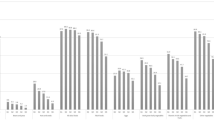Abstract
Objective: We investigated time trends in consumption patterns, and energy and nutrient intakes (protein, fat, carbohydrates, added sugars, vitamins A, E, C, B1, B2 and B6, niacin, folate, calcium and iron) from fortified food in children and adolescents between 1987 and 1996 in Germany.
Design: Mixed longitudinal survey (DONALD study) with 3 d weighed dietary records (n=2062 from 594 subjects), one subject per family per year chosen by random.
Setting: Dortmund (Western Germany) district cohort.
Subjects: 285 males, 309 females; mean age 6 y (2–13 y).
Results: Almost all children and adolescents consumed fortified food irrespective of the year studied. With the exception of vitamin E, significant time trends in the proportions of nutrient intakes from fortification were observed. The fortification of food with vitamins A, C, B1, B2 and B6 and niacin raised the already adequate intakes from non-fortified food (100% to 150% of reference intake values) by 20–50%. The fortification of food with vitamin E and folate raised the low intakes from non-fortified food (about 50% of reference intake values) to about 80% (folate) and 100% (vitamin E) of the references. Fortification of food with calcium and iron was not significant (<10%), but while total intake of calcium was adequate, total intake of iron remained critical.
Conclusions: Since the nutrient intake of the population of children and adolescents studied is adequate with respect to vitamins A, C, B1, B2 and B6, niacin and calcium, fortification seems inefficient, while fortification of food with vitamin E and folate, but not iron, improves an inadequate intake.
Sponsorship: The DONALD study is supported by the German Federal Ministry of Health and the North-Rhine-Westphalian Ministry of Science and Research.
European Journal of Clinical Nutrition (2000) 54, 81–86
Similar content being viewed by others
Author information
Authors and Affiliations
Contributions
Guaruntor: W Sichert-Hellert.
Contributors: WS-H initiated the evaluation, analysed the data and was primarily responsible for preparation of the paper. MK took part in the interpretation and the discussion of all results. UA assisted in the writing of the paper. FM designed the DONALD study and is head of the DONALD study team. All authors participated in preparation and subsequent revision of the paper.
Corresponding author
Rights and permissions
About this article
Cite this article
Sichert-Hellert, W., Kersting, M., Alexy, U. et al. Ten-year trends in vitamin and mineral intake from fortified food in German children and adolescents. Eur J Clin Nutr 54, 81–86 (2000). https://doi.org/10.1038/sj.ejcn.1600897
Received:
Revised:
Accepted:
Published:
Issue Date:
DOI: https://doi.org/10.1038/sj.ejcn.1600897
- Springer Nature Limited
Keywords
This article is cited by
-
Vegetarian diets in children: a systematic review
European Journal of Nutrition (2017)
-
Discretionary addition of vitamins and minerals to foods: implications for healthy eating
European Journal of Clinical Nutrition (2011)
-
Spectrophotometric Trace Determination of Iron in Food, Milk, and Tea Samples using a New Bis-azo Dye as Analytical Reagent
Food Analytical Methods (2009)




